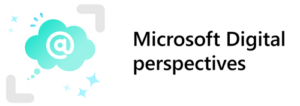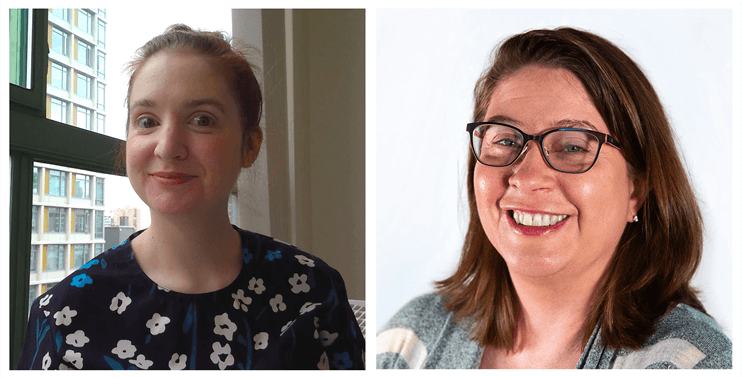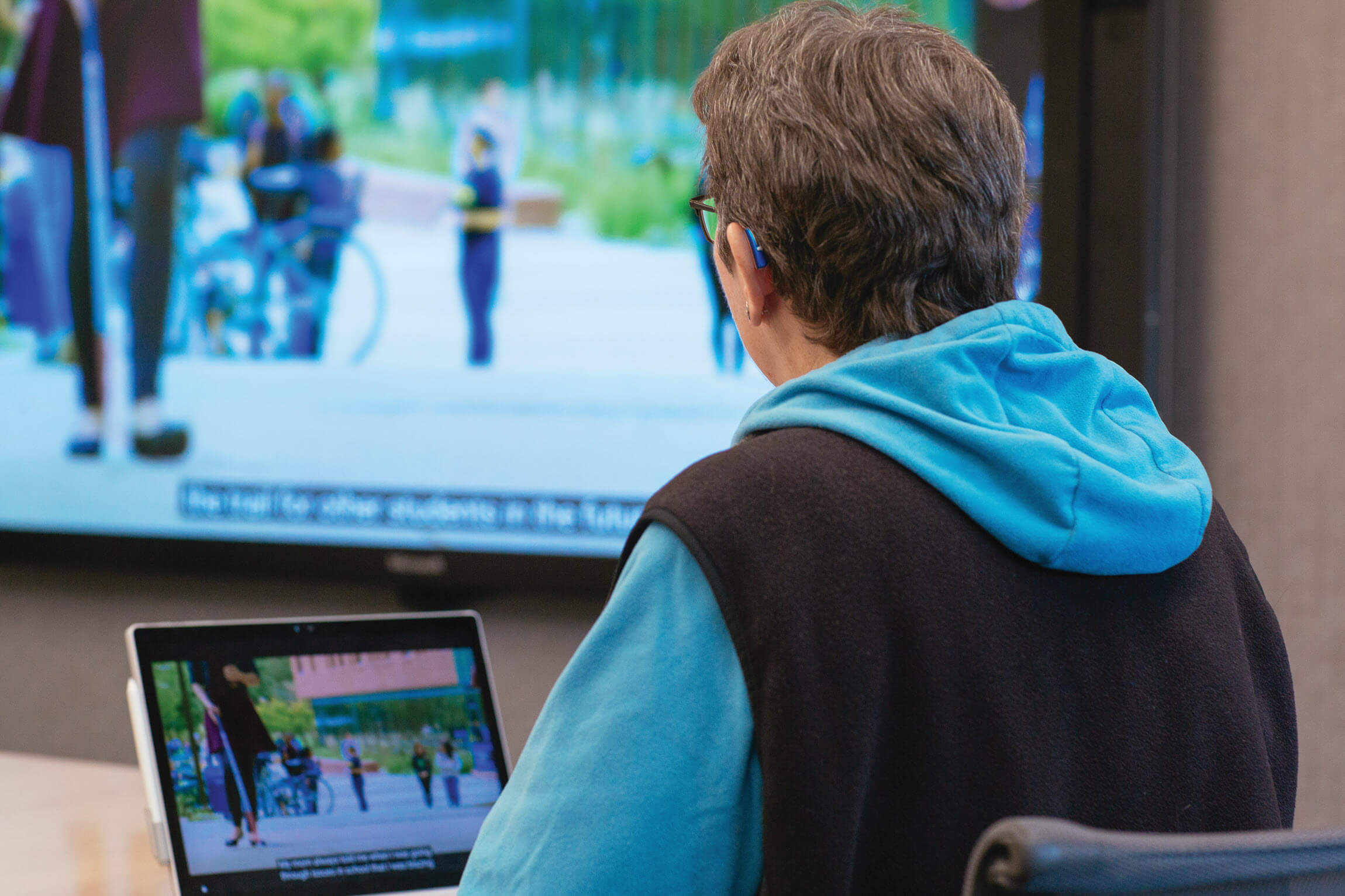This content has been archived, and while it was correct at time of publication, it may no longer be accurate or reflect the current situation at Microsoft.
 Hybrid work has inspired many changes at Microsoft, including how we support employees with accessibility needs.
Hybrid work has inspired many changes at Microsoft, including how we support employees with accessibility needs.
“We’re all working differently now because of hybrid work,” says Dawn Lee, a principal program manager on the Digital Studio team in Employee Experience. “We needed to make sure we didn’t lose any ground when it comes to enabling all employees, including people with disabilities, to be successful.”
We had an opportunity to get this right from the start. We find we’re way more effective with accessibility when we think about it before we start building something, and here we were launching a new way of working. This was the perfect opportunity to make sure our experiences and behaviors were as inclusive as possible.
—Joanna Briggs, senior program manager, Digital Studio team, Microsoft Digital Employee Experience
To support different work styles, that meant new norms would need to be established, and that work would need to be done to make sure that those changes in behavior were inclusive.
“We had an opportunity to get this right from the start,” says Joanna Briggs, a senior program manager on the Digital Studio team in Employee Experience who also identifies as having disabilities. “We find we’re way more effective with accessibility when we think about it before we start building something, and here we were launching a new way of working. This was the perfect opportunity to make sure our experiences and behaviors were as inclusive as possible.”
Here are five things we’ve learned about building experiences and creating work environments that are inclusive of everyone.
[Find out how Microsoft’s fresh approach to accessibility powered by inclusive design. Learn how Microsoft is using insights from employees with disabilities to build accessible employee experiences. Check out how Microsoft is having inclusive and effective meetings with Microsoft Teams. Read Microsoft’s tips for staying productive in an evolving hybrid world.]

Tip one: Make sure your meetings are inclusive
Microsoft employees are now spending much more time in Microsoft Teams meetings. Even when people return to the office and join meetings from conference rooms, they are often still using Teams. The Digital Studio team learned that one of the best ways to increase inclusion in hybrid meetings is to designate a moderator.
A moderator can keep track of who uses the “raise your hand” feature in what order, and they can make sure that contributions provided in the chat window aren’t lost. A moderator can pick the best time to share questions and contributions from the larger group. “This makes the experience more accessible for everyone,” Lee says. “Yes, this helps people with disabilities, but it also helps everyone, for example, those who have background noise who can’t come off mute.”
Accessibility Checker will let you know what you need to do. You can have it running while you work so that it flags issues as you go, helping you learn how to create more accessible content as a natural way of working. This also saves time rather than waiting until you’re done with a really great slide and then realize there are many accessibility issues to resolve.
—Dawn Lee, principal program manager, Digital Studio team, Microsoft Digital Employee Experience
There are core features in Microsoft Teams that also help, including live closed captioning, live translation, background noise reduction, dedicated chats for each meeting, and the ability to record meetings so people can listen later at their own pace.
Tip two: Ensure that your content is accessible
Ensure your content, whether it be the PowerPoint decks and videos you share in your meetings, or emails, SharePoint posts, or other communications, is accessible to people with disabilities. You can run Accessibility Checker on much of this content.
“Accessibility Checker will let you know what you need to do,” Lee says. “You can have it running while you work so that it flags issues as you go, helping you learn how to create more accessible content as a natural way of working. This also saves time rather than waiting until you’re done with a really great slide and then realize there are many accessibility issues to resolve.”
For content that doesn’t have Accessibility Checker, you can quickly get the hang of manually adding alternative text to anything that a screen reader can’t see and translate.
“For example, there was a reorg email that went out,” Lee says. “All of the information was included in a PowerPoint deck that didn’t go through the Accessibility Checker. People who use screen readers didn’t have a full understanding of what the re-org meant for them or the organization at large because there wasn’t alt text on the images and the reading order wasn’t correct.”
Another important tip is to have speakers introduce themselves in captioned videos, something that often gets overlooked as well, Briggs says. “People are less likely to understand what someone is trying to say when the presentation switches over to a video if they don’t understand who the people are and what their roles are,” she says.
Finally, sending content before you share it in a meeting is highly recommended as well as it benefits many situations—including people who want more time to process and think about what’s going to be discussed.
Tip three: Make chat welcoming for all
Shifting to hybrid has significantly reduced the amount of time we spend with each other in person, which has limited our ability to bond and have fun with teammates. One of the ways we’ve replaced conversations in the hall, over lunch, and at morale events is by chatting in Microsoft Teams.
During casual interactions in this virtual environment, new kinds of cultural references can come up and create situations where some people, including those with disabilities, might feel left out. One way this can play out is when people share animated GIFs that don’t come with a label explaining what they mean.
“Now our team writes out what a GIF means,” says Briggs, who says this—like all accessible-friendly actions—can benefit everyone. “Myself and others didn’t grow up with Star Wars, so posting a baby Yoda dancing meme could go over our heads without an explanation.”
Tip four: Understand the value of diverse perspectives and experiences
One of the most important things we’ve learned along the way is that to create solutions, we need to have an advisory community made up of people from the disability community and accessibility experts. We are better at building tools and services that empower our employees to do their jobs effectively when we do it together with input from everyone.
“It’s critical to have the perspective and influence of people who understand what is needed for an application to be truly helpful and inclusive, because of their own lived experiences,” Briggs says. “It was really important for us to build a lasting and healthy relationship with the accessibility community at Microsoft.”
The Digital Studio team has also been focused on getting teams across Microsoft Digital Employee Experience to consider accessibility before they get started on new tools and experiences.
Encouraging teams to shift left was in place before the pandemic, which has helped the org stay focused even as pressures to adapt and change to support new ways of working including hybrid has increased, Lee says.
“We encourage individuals to think about accessibility in the context of their engineering discipline—how can you incorporate accessibility into your engineering practices,” she says. “As with any issues, identifying problems earlier in the process will reduce your cost in terms of time and effort.”
Tip five: Make training your foundation
The most foundational thing that we do is to make sure everyone in our organization has access to accessibility learning resources tailored to their role, which builds upon the company-wide accessibility training that our Corporate External and Legal Affairs (CELA) team creates.
“One way we do that is with training that all new Employee Experience employees attend,” Briggs says. “During this training, accessibility has been elevated to the same level as other key topics such as security.”
The Digital Studio team champions additional accessibility training within the Employee Experience organization that is role-specific and amplifies opportunities that are offered by other teams across Microsoft or externally. One way the team incorporates learning about accessibility into the culture is the inclusion of an Accessibility Minute at quarterly all hands. This provides a forum for sharing quick tips or highlighting ways to learn and grow on a regular basis with the entire Employee Experience organization.

Tying it all together
At the end of the day, the most important thing we’ve learned is that getting accessibility right is a journey.
“We’re going to make mistakes,” Lee says. “The important thing is to be curious, to learn about accessibility, and to continue to explore how you can do things differently. It’s really an example of our growth mindset in action.”

- Learn about Microsoft’s commitment to accessibility.
- Watch to learn more about using accessibility features in Microsoft products.
- Find out how Microsoft’s fresh approach to accessibility powered by inclusive design.
- Learn how Microsoft is using insights from employees with disabilities to build accessible employee experiences.
- Check out how Microsoft is having inclusive and effective meetings with Microsoft Teams.
- Read Microsoft’s tips for staying productive in an evolving hybrid world.
- Learn how to use Microsoft’s Accessibility Checker.





